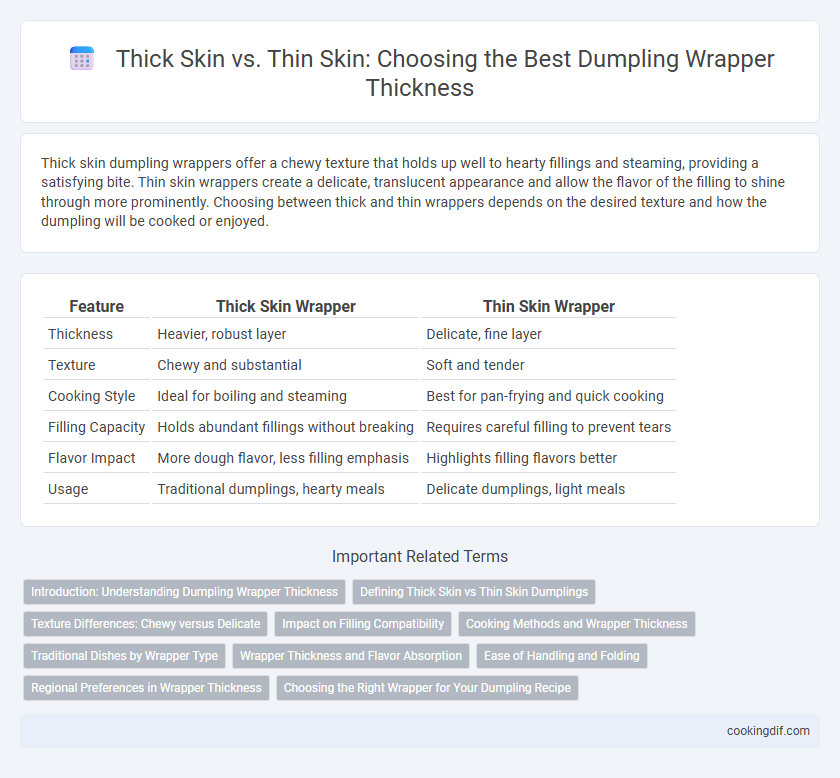Thick skin dumpling wrappers offer a chewy texture that holds up well to hearty fillings and steaming, providing a satisfying bite. Thin skin wrappers create a delicate, translucent appearance and allow the flavor of the filling to shine through more prominently. Choosing between thick and thin wrappers depends on the desired texture and how the dumpling will be cooked or enjoyed.
Table of Comparison
| Feature | Thick Skin Wrapper | Thin Skin Wrapper |
|---|---|---|
| Thickness | Heavier, robust layer | Delicate, fine layer |
| Texture | Chewy and substantial | Soft and tender |
| Cooking Style | Ideal for boiling and steaming | Best for pan-frying and quick cooking |
| Filling Capacity | Holds abundant fillings without breaking | Requires careful filling to prevent tears |
| Flavor Impact | More dough flavor, less filling emphasis | Highlights filling flavors better |
| Usage | Traditional dumplings, hearty meals | Delicate dumplings, light meals |
Introduction: Understanding Dumpling Wrapper Thickness
Dumpling wrapper thickness significantly influences texture and cooking outcomes, with thick skin providing a chewy, hearty bite ideal for robust fillings like pork or beef. Thin skin offers a delicate, tender texture that highlights subtle flavors in fillings such as vegetables or seafood while ensuring faster cooking and a lighter mouthfeel. Selecting the appropriate thickness depends on the desired balance between wrapper durability and overall dumpling experience.
Defining Thick Skin vs Thin Skin Dumplings
Thick skin dumplings feature robust, doughy wrappers that provide a chewy texture and strong structural integrity, ideal for holding hearty fillings and absorbing rich broths. Thin skin dumplings use delicate, translucent wrappers made from finely rolled dough, offering a light, tender bite that highlights the filling's flavor without overwhelming it. Choosing between thick and thin skins depends on desired texture, cooking method, and filling type, influencing the overall dumpling experience.
Texture Differences: Chewy versus Delicate
Dumpling wrappers with thick skin provide a chewy texture that enhances a hearty bite, adding substance and resilience to each mouthful. Thin skin wrappers create a delicate texture that allows the filling's flavor to shine through, offering a light and tender contrast. Choosing between thick or thin dumpling wrappers depends on the desired balance between chewiness and subtle tenderness in the overall eating experience.
Impact on Filling Compatibility
Thick dumpling wrappers provide durability, making them ideal for hearty fillings like meats and vegetables that require longer cooking times without breaking. Thin wrappers offer a delicate texture suited for light fillings such as seafood or finely minced ingredients, allowing the flavor to shine through with minimal dough interference. The wrapper thickness directly impacts filling compatibility by balancing structural integrity and flavor prominence, which guides the choice depending on the desired culinary experience.
Cooking Methods and Wrapper Thickness
Thick dumpling wrappers provide durability for boiling and steaming, preventing breakage and maintaining filling integrity under moist heat. Thin wrappers are ideal for pan-frying or steaming, offering a tender texture and allowing quicker cooking times while enhancing the delicate bite. Choosing the appropriate thickness balances cooking method and texture preference, ensuring optimal dumpling quality.
Traditional Dishes by Wrapper Type
Traditional dumpling dishes often employ thick skin wrappers for hearty fillings, as seen in Chinese baozi and Korean mandu, where the thicker dough provides a chewy texture that complements rich, savory ingredients. Thin skin wrappers are favored in dishes like Japanese gyoza and Vietnamese banh bot loc, offering a delicate, translucent layer that highlights the fresh, light fillings inside. The choice between thick and thin skins significantly influences the overall texture and flavor balance, making wrapper thickness a critical element in authentic dumpling preparation.
Wrapper Thickness and Flavor Absorption
Thick skin wrappers in dumplings offer a chewy texture and tend to hold fillings firmly, but they absorb flavors less intensely compared to thin skins. Thin skin wrappers, being delicate and translucent, allow for greater flavor absorption from the broth or dipping sauces, enhancing the overall taste experience. Balancing wrapper thickness with desired flavor intensity is crucial for achieving the perfect dumpling bite.
Ease of Handling and Folding
Thick dumpling wrappers offer greater ease of handling due to their sturdiness, reducing the risk of tearing during folding and sealing. Thin wrappers, while delicate and requiring more skill, create a lighter, more translucent texture that enhances the final dumpling's appeal. Optimal thickness balances flexibility and strength, ensuring smooth folding and a satisfying bite after cooking.
Regional Preferences in Wrapper Thickness
Regional preferences for dumpling wrapper thickness vary significantly, with northern Chinese cuisines favoring thicker skins for their robust, hearty dumplings, while southern regions often prefer thin skins to highlight delicate fillings and create a lighter texture. In Japanese gyoza and Korean mandu, thin wrappers are favored to achieve a crisp outer layer when pan-fried, contrasting with the thicker, chewier skins common in Chinese xiao long bao that need to hold rich soup inside. These regional thickness preferences reflect local tastes and cooking methods, influencing the overall dumpling experience across East Asia.
Choosing the Right Wrapper for Your Dumpling Recipe
Choosing the right wrapper thickness impacts dumpling texture and cooking method; thick skin wrappers retain more moisture and provide a chewier bite, ideal for soup dumplings or steamed varieties. Thin skin wrappers cook faster, allowing the filling's flavors to shine and offering a delicate, tender bite perfect for pan-fried or boiled dumplings. Consider the dumpling type and cooking style to balance wrapper thickness for optimal taste and texture.
Thick Skin vs Thin Skin for wrapper thickness Infographic

 cookingdif.com
cookingdif.com